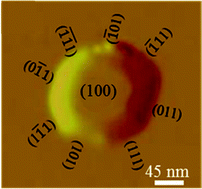High quality InP nanopyramidal frusta on Si
Abstract
Nanosized octagonal pyramidal frusta of indium phosphide were selectively grown at circular hole openings on a silicon dioxide mask deposited on indium phosphide and indium phosphide pre-coated silicon substrates. The eight facets of the frusta were determined to be {111} and {110} truncated by a top (100) facet. The size of the top flat surface can be controlled by the diameter of the openings in the mask and the separation between them. The limited height of the frusta is attributed to kinetically controlled selective growth on the (100) top surface. Independent analyses with photoluminescence, cathodoluminescence and scanning spreading resistance measurements confirm certain doping enrichment in the frustum facets. This is understood to be due to crystallographic orientation dependent dopant incorporation. The blue shift from the respective spectra is the result of this enrichment exhibiting the Burstein–Moss effect. Very bright panchromatic cathodoluminescence images indicate that the top surfaces of the frusta are free from dislocations. The good optical and morphological quality of the nanopyramidal frusta indicates that the fabrication method is very attractive for the growth of site-, shape-, and number-controlled semiconductor quantum dot structures on silicon for nanophotonic applications.


 Please wait while we load your content...
Please wait while we load your content...